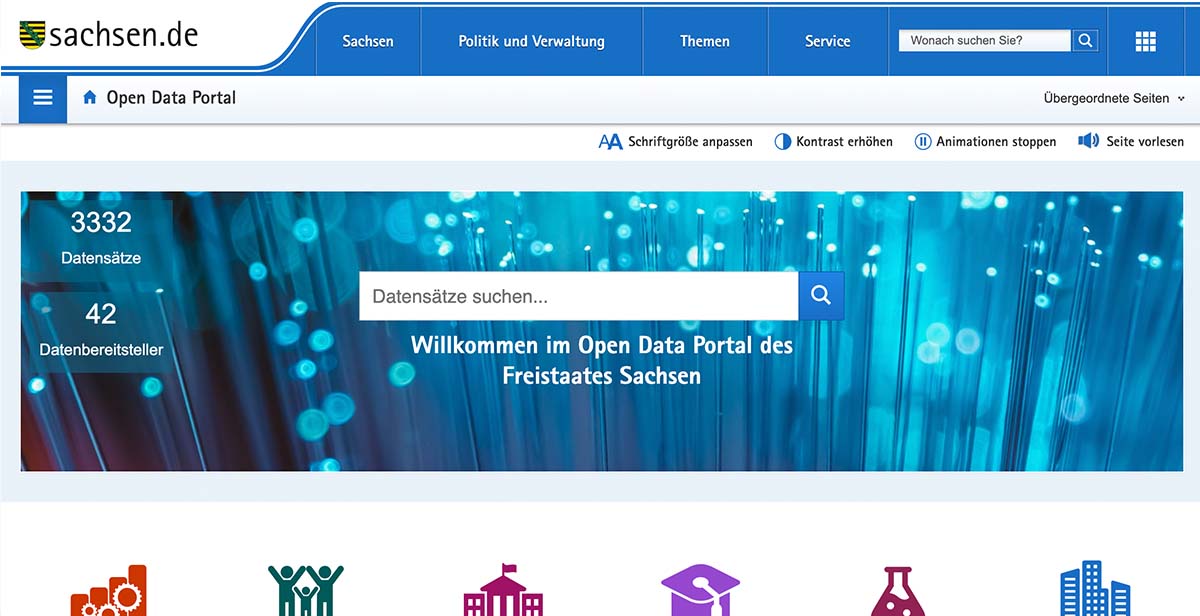Saxony on track with open data
The German state of Saxony, officially Freistaat Sachsen, has come a long way working with open data. In many aspects Saxony functions as a country on its own. Add to that the federal level, or Germany as a whole. And, of course, EU. A project for managing and publishing open data makes the data in Saxony available for everyone.

The crew working with open data in Saxony has a large degree of freedom. The different German states can do their own thing to a large extent. The real challenge concerning open data for Saxony is to get the different government agencies on the state level, and the different regions of Saxony, on board. On a regional level Saxony consists of 13 districts, of which three are urban districts, or simply big cities (Leipzig, Dresden, and Chemnitz). Add to this the lowest administrative level, which includes approximately 400 municipalities, or communities.
The trick is to work with open data in a centralised way that includes and offers benefits to the different participants. Or to put it simply: To create a win-win situation.
– We work with the government agencies on the state level and the districts as both providers and users of open data, with Saxony’s own portal for open data. We also try to get the communities involved as users of open data, says David Kilank, project manager for Saxony’s work with open data since two years back.
First data set published in 2018
Saxony’s open data project started in 2014. Several government agencies already published open data, but the aim for the project was to create a central open data portal for Saxony. The first open data set was published on the portal 2018. Different EntryScape modules from MetaSolutions have played an important part in the project, for example Registry and Catalog. The prevalent standard DCAT-AP has an adaption for Germany, DCAT-AP.de for open data and is used heavily, as expected.
What kind of data is published?
– Basically machine readable public data, like statistics of different kinds and geographical data. We don’t publish any personal data, says David Kilank.
In practice every government agency have their own data catalogs, for example the ministry of the interior and the ministry of finance. By using those catalogs data is harvested to the central portal where it’s published. The three big cities in turn have their own data portals. Data is harvested from those portals to the central Saxony portal.
– The idea is that end users can use the central portal to find and access all different kinds of data, says David Kilank.
At the time of writing 3 321 open data sets are published on Saxony’s portal.

Streamlining with open data
When asked about the major driving force behind Saxony’s open data project David Kilank cites legal requirements to publish public data as open data. But law fulfilment in itself isn’t enough to raise the interest in open data. Usability advantages for citizens, more effective administration and new business opportunities are other important aspects.
Seizing different kind of opportunities with open data is up to the different government agencies, districts, and also communities. And to private businesses, and individual citizens.
– We’re not responsible for the data content in the central project. Our mission is to provide the technical platform, to coordinate, and to provide advice and help to the different parties. In order to do that we need a technical platform, and that’s where EntryScape comes in. It wouldn’t be feasible for us to create our own technical solutions, explains David Kilank.
So far the breadth of open data published in Saxony is impressive. A quick glance on the portal’s start page reveals twelve main categories of data:
- Economy and finance
- Population and society
- Government and public
- Education, culture and sport
- Science and technology
- Regions and cities
- Environment
- Health care
- Justice and security
- Traffic
- Energy
- Agriculture
It’s easy to imagine use cases for the different kinds of data available. Taking advantage of new business opportunities involving open data requires some work, and innovation. It’s easier to see advantages for government administration, journalists, and individual citizens. And, not the least, central management of open data on the state level means more efficient management of open data itself.
While David Kilank is too modest to compare Saxony to other German states, he does mention that Saxony is ranked fifth among German states when it comes to open data. That’s not bad at all for a relatively small state, with approximately four million inhabitants.
The key ingredients in Saxony’s success with open data are a central technical platform available to all parties involved, the use of established standards, and close cooperation with everybody who have an interest in open data (at state level, government agencies, and districts).
The solutions is today based on the German DCAT-AP.de profile supported by EntryScape Catalog for editors to publish new datasets. Datasets that are maintained elsewhere are harvested to EntryScape Registry that validates them vs DCAT-AP.de then makes all data searchable on the dataportal. The portal uses EntryScape Blocks with the design chosen by Saxony. You can explore all data on https://www.opendata.sachsen.de/
Ta del av fler kundcase
Forsakringskassan
Försäkringskassan - an important component of society's continued digitalisation [...]
Skovde kommun
Skövde municipality at the forefront of open data [...]


